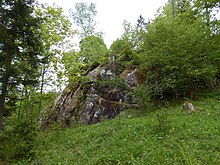Luegibodenblock
The Luegibodenblock near Habkern in the Bernese Oberland is the largest boulder in Switzerland. It is recorded in the federal inventory of landscapes and natural monuments of national importance .
geology
The granite block is about 10 meters high and about 30 meters long and wide. It has a volume of around 13,000 cubic meters. About half of the stone is sunk into the swampy moorland of the Lombach Valley and partially overgrown with grass and bushes.
It is doubtful whether the erratic block is a boulder in the geological sense. It was formed during the formation of the Alps around 300 million years ago in a mountain that was swallowed by the folding of the Alps and of which only a few blocks remained in the mud of the sea that was formed at that time. So, if at all, it was only transported briefly by a glacier.
The granite that occurs in such blocks in the Habkern area has an unusual yellowish-red hue and is particularly fine and hard, as it was not mechanically stressed during the folding of the Alps. It was therefore popular as a decorative stone , for example for facades. A grave stone made of Habkern granite has long been a status symbol in the Oberland.
history
In 1841 Jakob Zimmermann bought the Luegibodenblock from the Bäuert (civic community ) Schwendi for 400 francs to dismantle it. He wanted to sell the granite to the city of Bern, which wanted to use it to decorate the bridge arches, parapets and cornices of the Nydegg Bridge . The Bern building management finally decided not to buy it because of the color of the granite.
Zimmermann sold the Luegibodenblock to five local politicians who also wanted to dismantle it, but did not come to an agreement with the landowners about the routing of the necessary road. Only a small piece of the block was dismantled and made into the base of a monument in Neuchâtel. For a long time it was also believed that a Habkern granite slab that Switzerland gave to the USA in 1852 for the construction of the Washington Monument came from the Luegiblock. In fact, it was taken from another boulder in the Lombachtal.
In order to save the Luegibodenblock from being dismantled, the Natural Research Society collected 942 francs in 1868 to buy the block. She donated it to the Natural History Museum in Bern , to which it has belonged since 1869 with an official value of 980 francs. The Luegibodenblock has been the first erratic boulder in Switzerland to be under state protection since 1868. An inscription and a plaque on the stone commemorate this rescue operation, which is considered to be the birth of Bern's nature conservation.
swell
- Matthias Baumer: The biggest boulder.In: Swiss Radio DRS . 18th July 2013
- Sarah Neuhaus: The size is not important. In: Jungfrau newspaper . April 19, 2016
